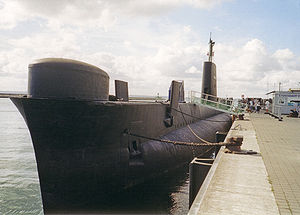Oberon-class submarine

HMS Otus moored at a dock in 2002.
|
|
| Class overview | |
|---|---|
| Name: | Oberon |
| Builders: | |
| Operators: | |
| Preceded by: | Porpoise class |
| Succeeded by: | Upholder class |
| In commission: | 1960–2000 |
| Completed: | 27 |
| Retired: | 27 |
| Preserved: | 8 complete, 3 partial, 1 awaiting conversion |
| General characteristics for Royal Navy submarines | |
| Type: | Attack/Patrol submarine |
| Displacement: |
|
| Length: | 295.2 ft (90.0 m) |
| Beam: | 26.5 ft (8.1 m) |
| Draught: | 18 ft (5.5 m) |
| Propulsion: |
|
| Speed: |
|
| Range: | 10,350 nautical miles (19,170 km; 11,910 mi) at surface cruising speed |
| Test depth: | 650 ft (200 m) |
| Complement: |
|
| Sensors and processing systems: |
|
| Electronic warfare & decoys: |
MEL Manta UAL or UA4 radar warning |
| Armament: |
|
| Notes: |
|
The Oberon was a ship class of 27 British-designed submarines operated by five different nations. They were designed as a direct follow-on from the Porpoise-class: physical dimensions were the same, but stronger materials were used in hull construction, and updated equipment was fitted.
The submarines were built between 1957 and 1978 by four shipyards: Cammel Laird (4), Chatham Dockyard (6), Scotts Shipbuilding and Engineering Company (11) and Vickers-Armstrongs (6). Thirteen of the submarines were operated by the Royal Navy, six by the Royal Australian Navy, three by the Brazilian Navy, three by the Royal Canadian Navy/Canadian Forces Maritime Command (plus two ex-Royal Navy boats later acquired for non-commissioned roles), and two by the Chilean Navy.
The Oberons operated during the height of the Cold War, with duties including surveillance, tracking of other ships and submarines, delivery and retrieval of special forces personnel, and serving as targets for anti-submarine training. Submarines of the class were in service until 2000. As of 2015, eight of the submarines are preserved intact as museum vessels, another three are partially preserved (with some exterior portions of the submarine on display), and one is in private ownership and awaiting conversion for display. The rest have been sold for scrap, including one former museum vessel.
The 295.2-foot (90.0 m)-long Oberon class was based heavily on the preceding Porpoise class of submarines, which were in service from 1956 to 1988. Changes from the Porpoise design were primarily to improve the strength and stealth of the submarine. Instead of UXW steel, the hull was built from QT28 steel, which was easier to fabricate and stronger, allowing the submarine to dive deeper.Glass-reinforced plastic was used in construction of the casing.
...
Wikipedia
